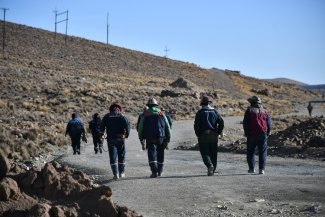Artist Lucía Camón walking through the streets of Torralba de Ribota with Pilar Sos, one of the doyennes of the village.
Almost 400 people left over a period of just fifty years. It was not a natural disaster but the promise of a better future that emptied the fields and extinguished the hum of voices from the schoolyard. Torralba de Ribota could have become one of the thousands of villages condemned to oblivion by Spain’s rural exodus. But it has been saved, by art.
This small municipality in the province of Zaragoza, Spain had been holding out for years with just over a hundred inhabitants, most of them very old. But in 2012 its old abandoned houses started to be occupied by newcomers from the city: a poet, a designer, a drama teacher, a painter and a photographer. This small community of artists have turned to life in the countryside to pursue their creative calling and, at the same time, to mitigate one of the chronic ills of the 21st century: rural depopulation.
Over 50 per cent of the global population now live in cities and the countryside is gradually being deserted. Only 23 per cent of Europeans live in rural areas and the loss of inhabitants is increasingly affecting countries such as Italy, Portugal and Spain. According to a recent report by the FEMP (Spanish Federation of Municipalities and Provinces), half of Spain’s municipalities are at risk of being depopulated and abandoned.
“Culture generates ideas, it is movement, it is life,” says Lucía Camón, promoter of the Pueblos en Arte cultural platform, an initiative designed to create a two-way bridge between the countryside and the cities.
The idea is to turn Torralba de Ribota and the other villages in the area into a magnet for artists. They organise workshops, exhibitions, film showings and offer an artist-in-residence programme through which people can seek inspiration, surrounded by silence, as did Dalí, Lorca, Machado, Rimbaud or Chopin, in their day. Some of their greatest works were created in a country home.
“It’s the perfect setting for creativity,” insists Lucía. This poet and video artist switched life in the trendy Malasaña neighbourhood of Madrid for a view of the rugged Armantes Mountains. She came with her partner, designer Alfonso Kint, and their little girl. They both admit that it was not easy in the beginning.
“You have to know how you’re going to make a living before coming to the village, and be aware that things are always slower here. You can feel very isolated at first, especially because the local authorities don’t tend to support young people who come along with ideas, which means you have to put all your energy into getting your project up and running.”
Despite the difficulties, they have promoted a wide range of activities over the last five years and have involved all the locals in them. “I go to everything they do,” says Pilar Sos. Aged 87, she is one of the village’s longest-standing inhabitants. Pilar remembers, with bittersweet regret, how her childhood friends ended up leaving for Zaragoza or Madrid, and how the sound of farmworkers singing in the fields gradually died out.
“The village has changed a lot, that’s why I’m so happy these young people are here. There’s a lot more life now. The village would probably have died out if they hadn’t come.” Seven houses have sold since art came and inhabited the narrow lanes of Torralba de Ribota.
Artist colonies in Italy and Portugal
According to the European Commission, 22 per cent of the people living in rural Portugal, Greece, Spain and Italy are old age pensioners. Only four people were left in the old centre of Favara, a small town in the south of Sicily, until 2010, when Florinda Saieva and Andrea Bartoli came to live there. To the surprise of the four elderly women still living in the derelict and semi-abandoned old town, the couple, Sicilian artists, managed to turn the place into a centre of artistic production, famed throughout Italy.
With the support of various friends from the world of culture, they managed to restore a good share of the houses and to turn the place into a huge arts space called Farm Cultural Park. In addition to the resident artists, the project attracts hundreds of visitors every year, who come to walk amongst its murals and outdoor works of contemporary art.
Portugal’s Aldeias artísticas are another successful experience that has been underway since 2014 in the hamlets surrounding the municipality of Castelo Branco. These small villages have become the setting for residencies for artists of all disciplines (urban art, illustration, graphic design, photography, theatre). They connect with the local community during their stay, and this union and sharing of experiences inspires new works that are then exhibited in the hamlet itself.
Similar initiatives can be found in Ireland, Bulgaria, Belgium and the United Kingdom. And an international project called Global Arts Village, currently in the research and development phase, has been launched to create an exchange network between rural artists around the world.
An economical investment
Despite the cuts suffered since the 2008 financial crisis, culture continues to be an economic driver capable of reviving activity in rural areas ravaged by unemployment. It is on this basis that artists are asking for more support, ranging from specific funding for cultural activities in depopulated environments to better Internet access in these traditionally disconnected spots. In Spain, 30 per cent of the municipalities are still limited to connection speeds of no more than 10 Mbps.
“Culture is one of the cheapest investments there is. Cultural activities can be held all year round with what it costs the local authority to hire a band or mend a street,” argues Lucía Camón.
“It’s not only about investing in infrastructure. Bricks don’t generate anything. But if you make interesting things happen in the village, people will come. The problem is that some of these villages are already convinced that they are going to die, they have admitted defeat.”
Artists are responding to the social concern generated by rural depopulation by proposing art to sow seeds of new life into these barren lands. Culture has always been rooted in the rural world. Culture comes from the Latin verb colere, which means ’to cultivate’.










